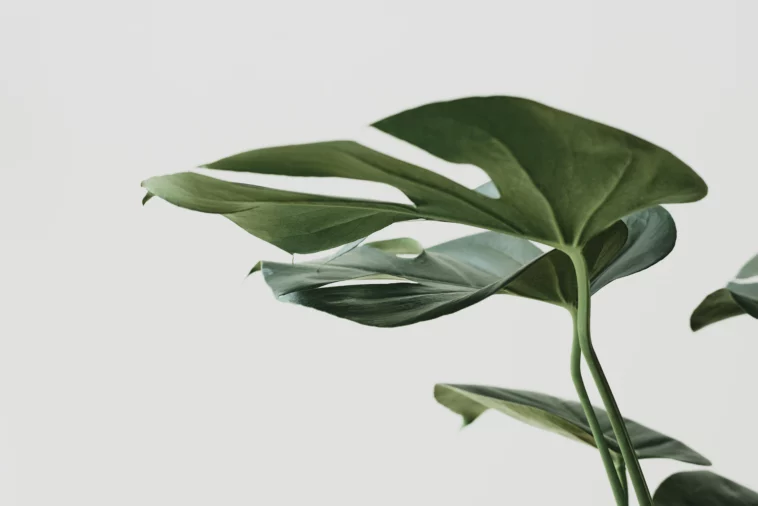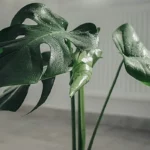Here’s an in depth guide to answer the question you probably asked – Why Does My Monstera Have Brown Spots?
Overwatering or poorly draining soil is the most prevalent cause of brown spots on yellow Monstera leaves. Brown spots may also be caused by other issues, such as too much direct sun, pests, overfertilizing, overwatering, or sudden changes in temperature.
Let’s go through each of these issues in depth to figure out what’s causing them and how we can guide you to fix your Monstera plant.
Table of Contents
Why Does My Monstera Have Brown Spots?
When grown properly, monsteras may grow to be gigantic. This plant’s natural home is the southern Mexican rainforests, so the more you can mimic that environment, the happier it will be.
However, because we are unable to transform our houses into little rainforests, certain errors are unavoidable.
It’s easy to find the source of most issues by paying careful attention to your plant, and most problems may be resolved.
Read More: How do you get rid of yellow leaves on Monstera?
Overwatering
If you overwater your Monsteras, you’re going to kill them in no time. Because they are epiphytes with aerial roots, monsteras are particularly sensitive to overwatering. To avoid root rot caused by suffocation, these plants need slightly moist soil.
When root rot takes hold, the plant will most likely display signs of discomfort in the shape of brown spots on its leaves, along with brown tips.
Poor drainage soil or a container with insufficient drainage holes may also allow the roots of the Monstera to remain in water for an extended period of time, resulting in root rot.
How To Fix Watering Issues?
Remember that plants don’t require as much water as you assume they do. Always inspect the soil’s top 2-4 inches for dryness prior to watering your Monstera. Even though the soil on the surface seems to be dry, the deeper layers, where the roots are located, may still be damp.
Take these steps if you think root rot has already set in:
- To check the roots, gently remove your Monstera from its pot. For rotten roots, look for dark, black, and mushy areas with an unpleasant odor.
- Pruning shears should be used to remove any infected roots.
- You may also remove the leaves that are most impacted by brown spots so that the remaining healthy roots will concentrate on maintaining the healthy leaves.
- After you’ve finished cutting the afflicted foliage, wash the undamaged roots well with clean water and repot your Monstera in a fresh pot with lots of drainage holes to finish the job.
- Fresh, dry soil is ideal for planting your Monstera. A mixture of two-thirds potting mix and one-third perlite is an excellent choice.
Although your Monstera may take a few weeks to adjust to its new surroundings, new roots and leaves should begin to grow shortly after.
Read More: Should I cut off yellow monstera leaves?
Underwatering
As overwatering is harmful to the health of a Monstera plant, and underwatering is also likely to cause the plant to become dehydrated, resulting in brown spots on the plant’s stunning leaves.
Keeping in mind that this plant is native to the tropics, humidity and moisture are essential for its survival. The key is to maintain consistently moist conditions throughout the year.
No doubt you are concerned about overwatering your Monstera, but please make sure that in your attempts to keep it healthy, you are not denying it the moisture that it needs in order to thrive.
How To Fix Underwatering?
It is critical to understand your Monstera’s water needs. There is a good chance that you know how often it has to be supplied with water. When the weather is hot and dry, its water needs will be much higher than when the weather is cooler.
A rootbound Monstera may also suffer from dehydration if the container does not have enough soil to keep the water. In such a situation, you’ll need to repot your Monstera in a larger pot.
Keep in mind that overwatering and root rot might occur if you drastically increase the size of the container. I recommend going with one that’s a few inches larger.
Disease
When a brown spot appears on a Monstera leaf, it might indicate the presence of a fungal or bacterial infestation.
Fungal infections are often shown as tiny brown spots that increase in number as the infection progresses.
If these spots are neglected, they will develop in size until they eventually merge together and create a large spot on the Monstera’s leaf. Then, the whole leaf will turn brown and die.
Some bacterial leaf spots look damp, while others appear to be bigger and more numerous on the leaves. Leaf spot infections, whether they are caused by a fungal or bacterial infection, must be treated as soon as possible.
How To Fix This?
For your Monstera to have a chance of survival, it is essential that you pinpoint the issue and take action to prevent the disease from spreading.
You should keep it apart from other houseplants as soon as you detect brown spots appearing on its leaves. It is essential to remove the afflicted leaf or leaves as soon as possible.
Lighting
Direct sunlight is often believed by Monstera owners to be safe. The plant, after all, is native to tropical rainforests!
The truth is that Monsteras grow under the shade of taller trees. So these plants are shielded from direct sunlight. Despite the fact that they get a lot of light, it’s mostly “indirect.”
The foliage of your Monstera is at risk of being burned if it is exposed to too much direct sunlight.
Variegated Monsteras are considerably less tolerant of light extremes, making the situation even worse.
How To Fix Lighting Issues?
Monsteras dislike bright light, yet you can’t put it in a dark place if you want it to produce those eye-catching, big, fenestrated leaves for which the plant is famous.
Choose a space that receives plenty of bright, indirect light and put your Monstera near a window to get the best results possible.
Fertilizer Burn
You fertilized your Monstera with a small amount of fertilizer. It performed well and had a fantastic appearance. So you gave it a bit of extra fertilizer, hoping discreetly that your plant would grow a few feet higher in the next two weeks.
Unfortunately, this did not occur, and your cherished houseplant now has multiple brown leaf spots, brown leaf tips, and brown leaf edges.
Does this tale ring a bell? If it seems familiar, you’re not the only Monstera parent who has made the mistake of overfeeding.
How To Fix Over Fertilization?
You should flush the soil to remove any accumulated salts from fertilizer if you believe over-fertilizing is the cause of brown spots, edges, and tips on your Monstera’s leaves. Make sure you don’t tamper with the roots. Then, cut the worst-affected foliage and make a commitment to yourself to never over fertilize your Monstera again.
Pests
Scale insects and spider mites are two common pests that attack Monsteras. Pests may have a severe effect on the general health of your Monstera, making them the plant’s most venomous enemies.
If they are not removed quickly enough, they may cause permanent harm. Because spider mites are so small, you may not notice them right away, but the following symptoms may indicate the presence of the pests.
- Brown, curled leaves with mottled yellow or brown markings and thin, wispy webs between the leaves are symptoms to look for.
- If you look carefully, you will see a large number of tiny spider mites, each a little larger than a pinhead, scurrying about their webs and munching on the leaves of your plant.
- As for scale insects, they’ve been known to attack the Monstera’s stem or leaf joints on the leaves.
Sudden unexpected leaf drop or yellow/white/brown patches on the leaves, branches, or stem are two tell-tale symptoms of their existence on your cherished Monstera plant.
Read More: Can you save yellow Monstera leaves?
How To Fix Pests Issues?
To begin with, keep your plant apart from the rest of your home’s plants in order to avoid the spread of disease. To get rid of as many bugs as possible, give your plant a vigorous wash with a showerhead or hose. Mealybugs and scale may also be manually removed.
Following this first treatment, the most popular and efficient way to get rid of pests infesting a Monstera is to use a Neem oil spray.
- Neem oil is not only an efficient insect repellent, but it is also a superb sterilant, preventing pests from reproducing in the future.
- Horticultural oil is yet another chemical-free and organic solution for controlling spider mites, scale, and other pests.
To get the greatest results, use two teaspoons of Neem or horticultural oil with one teaspoon of liquid soap in one liter of water. Spray the liquid immediately onto the afflicted leaves after thoroughly combining all of the components.
To ensure that all of the pests have been killed, I highly suggest doing this treatment every week for a few weeks. Only then should you securely relocate your plant to its original place.
Acclimation
If you observe brown spots on your Monstera shortly after repotting or transferring it to a new place, it is most likely undergoing acclimatization.
Because of the quick shift in the environment, the plant could get stressed and generate yellow or brown spots on its leaves.
How To Fix Acclimation Issues?
Isn’t it true that it takes some time to settle in and name a new location your home when you move?
The same is true for plants. If your Monstera is struggling to adjust to its new home, all you need to do is make it feel at home by providing it with the appropriate quantity of water, light, and fertilizer.
Read More: Can a yellow Monstera leaf turn green again?
Sudden Changes in Temperature
If you’ve read this far and still don’t understand why your Monstera has brown spots, you might be exposing it to temperature extremes or drafts.
There are numerous possible scenarios in which this might occur:
- Plants are quite often vulnerable to temperature extremes upon delivery or while on display in stores, which may cause your Monstera plant to suffer soon after you get it home.
- Your plant’s location may be an issue if it’s near a heating vent, an open window, or a radiator. Be sure to transfer your plant to an area where it will not be subjected to unexpected temperature changes.
- Remember to bring in your Monstera before the cool evenings of autumn/fall if you keep it outdoors throughout the summer. Cold night temperatures may cause significant temperature pressure, causing your Monstera to wilt and develop brown spots.
How To Fix Sudden Temperature Changes?
The only method to keep your Monstera from freezing is to relocate it to a warmer spot.
- Be sure that there are no chilly drafts around it.
- It’s important to keep your Monstera away from any heat sources, such as heaters or air conditioners.
Your Monstera is likely to recover if you transfer it to a warmer spot and treat it with care. It is possible to remove the damaged leaves and allow the remainder of the plant to recover.
Read More: How do you fix yellow Monstera leaves?
Conclusion
Why Does My Monstera Have Brown Spots?
Hopefully, you’re on your way to figuring out why your Monstera’s leaves are turning yellow with brown spots. Even though it’s disappointing to have a houseplant that’s struggling, I always learn so much from my mistakes than from my successes as a houseplant grower.
Read More: Will a yellow monstera leaf recover?


